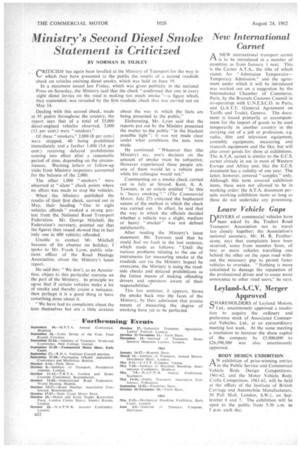illinistry's Second Diesel Smoke New International
Page 26

If you've noticed an error in this article please click here to report it so we can fix it.
Carnet
Statement is Criticized A is international transport carnet P-1 s to be introduced in a number of
BY NORMAN H. TILSLEY
rRIT1C1SM has again been levelled at the Ministry of Transport for the way in which they have presented to the public the results of a second roadside check on vehicles emitting diesel smoke, which was held on June 19,
In a statement issued last Friday, which was given publicity in the national Press on Saturday, the Ministry said that the check "confirmed that one in every eight diesel lorries on the road is making too much smoke "—a figure which, they contended, was revealed by the first roadside check that was carried out on May 14.
Dealing with this second check, made at 95 points throughout the country, the report says that of a total of 25,000 diesel-engined vehicles observed, 3,000 (12 per cent.) were "smokers."
Of these " smokers," 2,000 (8 per cent.) were stopped, 40 tieing prohibited immediately and a further 1.400 (5.6 per cent.) receiving delayed prohibitions coming into effect after a reasonable period of time, depending on the circumstances. Warning letters or follow-up visits from Ministry inspectors accounted for the balance of the 2,000.
The other 1,000 "smokers' were observed at " silent " check points where no effort was made to stop the vehicles.
When the Ministry published the results of their first check, carried out in May, their heading "One in eight vehicles offends" evoked a strong protest from the National Road Transport Federation. Mr. George Mitchell, the Federation's secretary, pointed out that the figures then issued showed that in fact 'only one in 600 vehicles offended.
Unable to contact Mr. Mitchell because of his absence on holiday, I spoke to Mr. Frank Lyon, public relations officer of the Road Haulage Association, about the Ministry's latest report.
He said this: "We don't, as an Association, object to this particular exercise on the part of the Ministry. In principle we agree that if certain vehicles make a lot of smoke and thereby create a nuisance. then perhaps it is a good thing to have • something done about it.
We have had no complaints about the tests themselves but are a little anxious about the way in which the facts are being presented to the public."
Elaborating, Mr. Lyon said that the reports put out by the Ministry presented the matter to,the public "in the blackest possible light "; it was not made clear under what conditions the tests were made.
He continued: "Whatever they (the Ministry) say, one's decision on the amount of smoke must be subjective. However experienced these people are, one of them would let a vehicle pass while his colleague would not."
Commenting on a smoke check carried out in July at Strood, Kent, A. A. Townsin, in an article entitled "So this is ' heavy smokinel " (The Commercial Motor, July 27) criticized the haphazard nature of the method in which the check was carried out. In effect, he said that the way in which the officials decided whether a vehicle was a slight, medium or heavy "smoker" was not defined satisfactorily.
After reading the Ministry's latest statement. Mr. Townsin said that he could find no fault in the last sentence, which reads as follows: "Until the various problems relating to the use of instruments for measuring smoke at the roadside can (as the Ministry hopes) be overcome, the Ministry is using the roadside checks and delayed prohibitions as the fairest means of making offending drivers and operators aware of their responsibilities."
This last sentence, it appears, blows the smoke back into the faces of the Ministry, by their admission that precise means of measuring the degree of smoking have yet to be perfected.








































































































